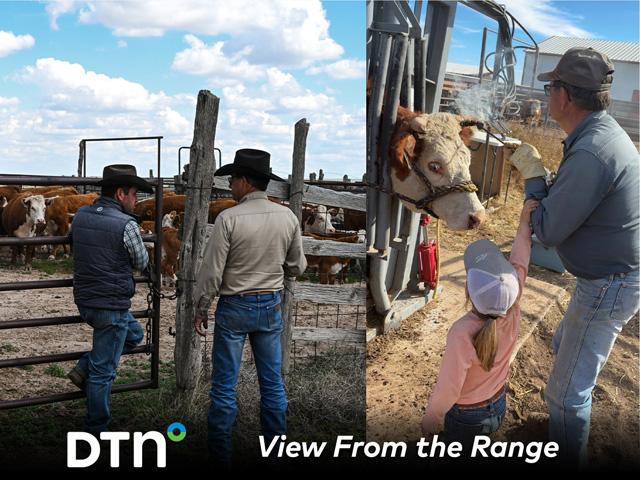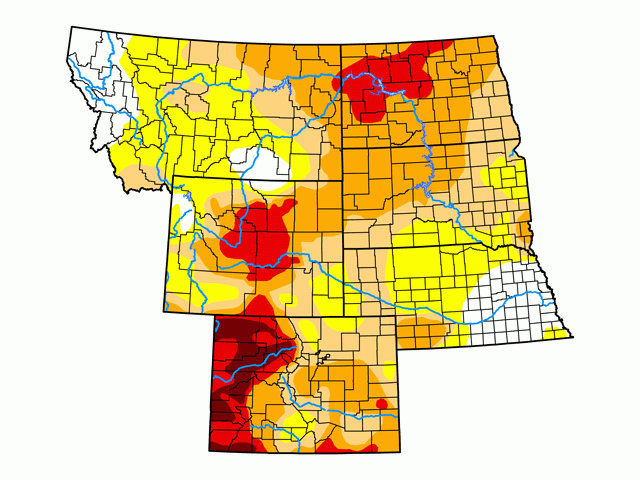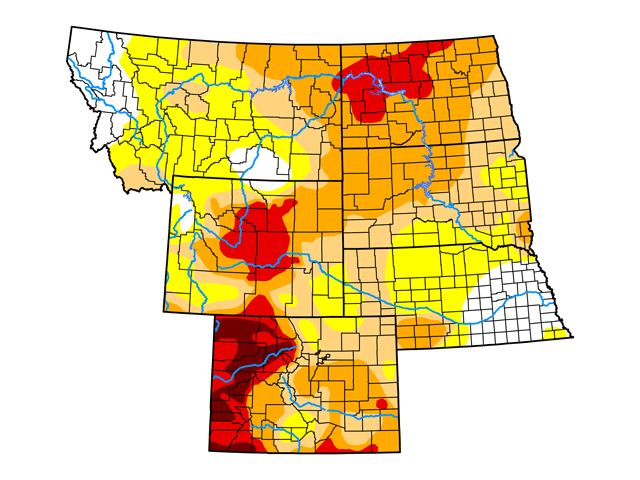Market Matters Blog
Will Current Drought Affect 2021 Spring Wheat Planting Intentions?
In their March 25 North Dakota Drought Briefing for late March into April, the National Weather Service said, "Extreme drought has been introduced across parts of northwest and north-central North Dakota early in the spring season. The rest of the state is designated as being in either moderate or severe drought. Drought is likely to persist or worsen through the spring and into the summer." (https://www.weather.gov/…)
Nearly 17% of North Dakota, primarily in the northwest and including all but the northernmost section of Ward County, is currently in extreme drought, according to the March 23 Drought Monitor. Most of the remainder of the state is rated as being in severe drought. Western South Dakota and eastern Montana are also experiencing severe drought conditions, with a section of northeastern Montana in extreme drought.
"I took a moisture probe of my soil and found only 14 to 16 inches of subsoil," said Leonard Schock, Vida, Montana, which is in the severe drought area. "We have had maybe half of our annual precipitation and that will change my plans for spring wheat planting. Of my 6,000 acres, I have 1,500 acres of hard red winter (HRW) wheat on fallow ground, which is still wet from 2019."
Besides the drought affecting a big drop in spring wheat acres, Schock said the current yellow pea new crop price of $6.50 per bushel makes it more lucrative to plant peas. "Peas are a good rotation crop for spring wheat and on top of that, input costs are about 70% of spring wheat costs and pulses can survive on less moisture." Schock said there will be substantially less spring wheat acres there this season, but he will rotate planting spring wheat and peas to start.
A Pacific Northwest exporter who procures wheat from northeast Montana and northern parts of the Golden Triangle said the very dry conditions are an issue for farmers there and little seeding activity has started. The lower triangle has gotten more moisture but farmers there are still behind. However, they will plant no matter what, he added.
"Seed it and forget it," said Peter Ness, Sharon, North Dakota, when asked about planting spring wheat. "I am putting in 800 acres, down a little because I'm going with 300 acres of barley this year too." Ness said he may wait to seed until after April 10.
Darrin Schmidt, who farms in eastern North Dakota, said, "All acres look like they will be planted. It is dry but luckily, we have subsoil moisture to get us started. Some neighbors are worried about germination but I'm not there yet. We are going to change some practices to hopefully conserve some moisture. We are at 1,500 acres of wheat, which is down from previous years because of price action."
"With the dry winter and the rain in August last fall, we could get an early start and likely plant every intended acre, which hasn't happened in three years," said Cory Tryan, grain department manager at Alton Grain Terminal LLC in Hillsboro, North Dakota. He estimated spring wheat acres may be down 10%, but corn acres will be the winner this year in his area because most of the idled prevented planting acres will go to corn.
Keith Brandt, general manager of Plains Grain and Agronomy LLC in Enderlin, North Dakota, said, "It looks like we are going to have early to normal planting dates this year, which should increase our wheat acres about 20% to 25%. That's only because last year it got so late that our wheat acres were down 30%. We had 30% to 35% of our cropland in prevented planting last year, but all that ground got worked last fall plus some additional ground got worked because of our drier fall. Everyone will plant up to their base acres of corn."
Brandt added that most of the additional acres of corn in the U.S. this year will be in North Dakota. After that, it will go to soybeans and canola. "Southeast North Dakota is sitting very good for moisture now," he added.
"I'm half done applying NH3 already and it's the 25th of March," said Kerry Baldwin, who farms in Hope, North Dakota. "I don't recall ever getting going this early. I'm planning on planting around 200 acres of wheat and the rest of my 2,500 acres will go to corn and soybeans. While it is dry here, at some point we will get some rain and I'm not worried about that. It's nice to see prices up; now to get everything planted and hope we have some exceptional yields."
P[L1] D[0x0] M[300x250] OOP[F] ADUNIT[] T[]
Allan Klain, who farms northwest of Turtle Lake, North Dakota, said, "Wheat acres will be down in my area. Durum has turned into a minor crop by us and is less than flax in popularity. Soybeans, canola and corn will gain acres, but none of this matters unless we get some substantial moisture. I spoke to my crop insurance guy and was told rock hard dry soil is not a reason for prevented planting."
Klain added, "I hate to be gloom and doom, but the next two-week and 60-day forecast isn't looking good for rain.
Bryan Kenner, Maddock, North Dakota said, "It looks to be an interesting year here. We are as dry as we've probably been since the late '80s. I don't know many farmers that have ever been in the field in March before in my area and I think we could go anytime if we want. I'm optimistic we will get moisture but it's dry enough that it is a concern if we have enough moisture to get the wheat germinated. It's definitely a bigger issue west of me from what I hear."
"I am planning 1,000 acres of spring wheat and at this point I can get it in the ground if needed," said Matt Undlin, Lansford, North Dakota. "We don't have enough moisture to get it to germinate yet and our subsoil moisture was depleted last year, so it will take rain to make grain. We are in the D-3 drought in Lansford, and pasture conditions and water holes are dry. Rugby and west is also dry. In our area there will be more canola and beans than normal unless we see a market rally to buy more acres."
Undlin said wheat seed sales have been steady and this drought seems to cover large parts of North Dakota specialty crop acres of peas, lentils, chickpeas, flax, barley and durum. He thinks in the next month, acres will be switching to follow as the markets rally.
"We were in a D-3 drought for the last two years for a few months, but this time it's really taking its toll because of how dry we were going into it. Fires are almost a daily occurrence," added Undlin.
"We are one field done and 40 acres into 900 acres of wheat," said Paul Anderson, Coleharbor, North Dakota. "It feels like the 25th of April. Soil is handling nice. Fertilizer prices have tripled since last fall and my soils require a $120 per acre fertilizer budget for a profitable wheat yield. Wheat seed sales were slow this year and there is more interest in our soybean seed. Got about .08 inch of rain midweek but will need a lot more to make a crop."
Jim Peterson, North Dakota Wheat Commission's policy and marketing director, told DTN, "Our current bias is for a 5% to 10% cut in hard red spring (HRS) wheat acres across the state as a whole, with the sharper reductions in the eastern half of the state where corn and soybeans are more competitive. Canola and pulse crops are also competing hard for acres in more northern areas of the state and fertilizer prices and availability certainly favor pulses and soybeans over wheat, corn and canola.
"Out west, where there is more livestock, I think annual hay crops like oats, millet, hay barley, et cetera, will also compete for acres, considering how dry it is. Cattle producers will cut into already short hay reserves if they have to feed longer into June until pastures emerge. Of course, if it remains dry, there will be some herd culling that will need to occur."
Peterson added, "While wheat prices have gained over the winter, they have not appreciated enough in my mind to sway producers from the alternatives, even though new-crop price spreads are not as wide as current price spreads between crops. Certainly, prices are not the only variable, but it is a big one, and while $6 to $6.50 wheat prices are good historically, they are not high enough relative to the prices seen with other crops.
"With that said, the year-to-year improvement in crop insurance coverage prices for HRS wheat are actually better than year-to-year cash market values. We have had some tremendous wheat yields the last few years, so insurance coverage on wheat competes well with other crops in more central to western areas, and if soils remain dry, they may still go with HRS wheat since you can plant it deeper and harvest it a bit sooner than other crops like soybeans and corn, which need August rain and subsoil moisture. Seed costs are also cheaper for HRS wheat."
Peterson added, "As for durum, we are still thinking of a marginal increase, but not as much as thought earlier, again due to the fact that prices have not appreciated to the same level as other crops. Thinking of no more than a 10% gain, and maybe that is still too high."
SOUTH DAKOTA AND WESTERN MINNESOTA HRS PLANTING INTENTIONS
"We intend on starting Friday (April 2), but most farmers will let it rip in the coming week," said Tregg Cronin, Gettysburg, South Dakota. "Our spring wheat acres will be up about 10% this year, due mainly to rotations as opposed to economics or any other considerations. The large prevented planting acres the last two years have kind of wreaked havoc on our rotations so still trying to get things back in line. Generally, most of our prevented planting from last year is slated for corn due to more chemical options for weed control.
"Moisture is a big concern, although the couple inches of wet snow last week should soften the ground up enough to germinate the wheat, and 2017 is fresh in many people's minds. We will need moisture right away in April to keep prospects alive," Cronin said. "I don't think there will be anyone waiting for moisture to start planting; the seed is better off in the ground than in the bin!"
Tim Luken, manager Oahe Grain in Onida, South Dakota, said, "The market says plant corn and beans, but famers' ideas around here are up in the air. Some will cut back on spring wheat; some will stick with the rotation and some may not plant any. We have seen some acres planted in the last two weeks, but we had a couple snow issues along with cold weather stopping all planting at this time. Guessing over the weekend or in the coming week we may see machines moving, scratching around."
"On our farm, we stick closely to our rotation so our spring wheat acres will be about what we normally plant," said Ryan Wagner, Roslyn, South Dakota. "There is quite a bit of prevented planting acres in our area and I think the vast majority of those acres will be planted to corn and soybeans. I think I've said this for the last several years, but as far as spring wheat going in northeast South Dakota, it's just the diehards left that either grow it for seed or like it as a rotation crop because the profitability for spring wheat just isn't competitive with corn and soybeans right now."
Wagner added, "I see a slight drop off in acres this year, but those who have grown spring wheat in the past will likely continue to grow it this year, possibly just not quite as much of it. We have no snow cover and the frost is almost completely out already and we have missed the last few rains so we could be in the field as early as this week."
"Wheat will be zero acres here this year due to prices of other commodities," said Matthew Krueger, who farms in East Grand Forks, Minnesota. "Last year's prevented planting acres will likely be a 50/50 combination of corn and beans. We had over 1,100 acres last year in prevented planting."
"I think spring wheat acres will be down in Minnesota and North Dakota due to higher corn and soybean prices," said Tim Dufault, a farmer from Crookston, Minnesota. "Wheat prices just have not seen the rise in prices that those two crops have. I visited with a couple of farmers from southeastern North Dakota and west-central Minnesota and they both felt there would be a lot less wheat planted in those areas."
Dufault added, "We are dry in northwestern Minnesota, but I want to add a disclaimer: We are only one good thunderstorm from being too wet. A dry spring will help us start planting a little earlier than usual; an early spring may get a few more wheat acres seeded than planned for farms in the northern end of the state where corn isn't as good of an option."
As Paul Anderson concluded, "Plant in dust, bins will bust." That certainly rings true currently for some of this planting season in the areas suffering from drought.
Mary Kennedy can be reached at mary.kennedy@dtn.com
Follow her on Twitter @MaryCKenn
(c) Copyright 2021 DTN, LLC. All rights reserved.





Comments
To comment, please Log In or Join our Community .